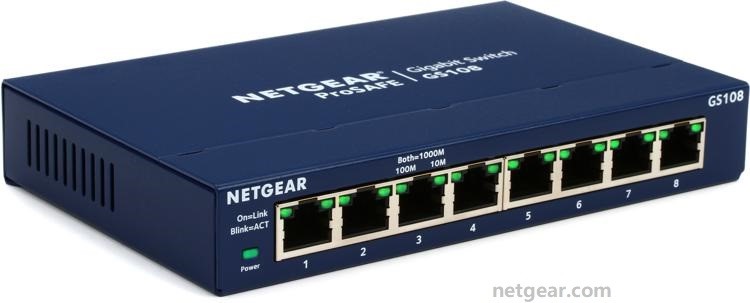This post is going to introduce you a network device – Ethernet hub, mainly including its basic information, main types, and applications in the life.
An Overview of Ethernet Hub
Ethernet hub refers to an electronic device that runs a computer network. It is simple and can be configured easily. It acts like a repeater. Ethernet hub is also called active hub, network hub, multiport repeater, or simply hub.
Network hub can also connect multiple Ethernet devices together and make them act as a single network segment. It contains multiple input/output ports. A signal introduced at the input of any ports appears at the output of every port except the original incoming (without looking at IP address for the data’s destination).

That is to say all devices in this network will receive all the data. The Internet hub doesn’t operate Ethernet traffic. Plenty of hubs have LED signal lamps that can show the state of the hub. A collision usually occurs when two or more devices on the same network attempt to send packets simultaneously.
However, hubs cannot allow devices to send and receive data at the same time in more technical terms. This phenomenon is called half-duplex communication. It can cause data holdups, collisions, and network slowdown.
Once the collision happens, all of the devices have to go through a routine to fix the conflict. This process is configured in the Ethernet Carrier Sense Multiple Access with Collision Detection (CSMA/CD) protocol.
Top recommendation: What Is Ethernet Splitter and How Does It Work
Ethernet Hub Types
Here are three main types of Ethernet hubs on the market. They are illustrated one by one in the content below.
- Hub: It does not look at individual packets and copies them to all ports, which is used for connecting LAN segments.
- Passive hub (also called intelligent hub): It supervises traffic going through the hub. All ports can be configured. Given to that fact, this hub is also referred to as manageable hubs.
- Switching hub: It reads the destination address of each packet and then sends the packet to the correct port.
You may also like this: What You Should Know about Ethernet Frame Format? Details Here
What Does an Ethernet Hub Do
Ethernet hub connects broadcasts signals to computers in a Local Area Network via the frame flooding process. The network hub cannot differentiate MAC addresses as it doesn’t have the required software to recognize specific targets.
In essence, the Ethernet hub is an unintelligence device. Each incoming bit is copied on all other interfaces. The Internet hub is the easiest and least way to build computers within a same network.
Ethernet hub also has its drawback. For instance, it has unnecessary traffic because of the spammy transmission process.
In addition to that, the Ethernet hub is not safe because it may send data that is not planned for all end-users. Where is the Ethernet hub used for? To sum up, it has 3 applications. An Internet hub can insert a protocol analyzer into a network connection. Hence, the hub is regarded as an alternative to a network tap or port mirroring.
The network hub prevents a loop by accidentally connecting two ports together. This operation may cause issues when switches are used. It can work on physical layer of OSI.
Bottom Line
In conclusion, this post introduces the general information, main types, as well as application of Ethernet hub. Now, you may have an overall understanding of Internet hub. Here comes the end of the article.